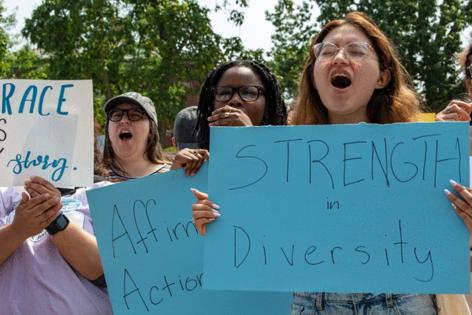Heidi Stevens: Banning DEI and race-based programs in schools chips away at the very mission of education
Published in Lifestyles
On Valentine’s Day, the Department of Education sent a “Dear Colleague” letter to schools across the country giving them two weeks to stop taking race into consideration for admissions, hiring, promotion, compensation, financial aid, scholarships, prizes, administrative support, discipline, housing, graduation ceremonies “and all other aspects of student, academic and campus life.”
Institutions — preschool, K-12 and colleges and universities — that fail to comply face the loss of federal funding.
“In recent years,” the letter states, “American educational institutions have discriminated against students on the basis of race, including white and Asian students, many of whom come from disadvantaged backgrounds and low-income families.”
The letter reminds schools of the 2023 Supreme Court ruling that effectively barred affirmative action. But it doesn’t stop at the admissions process — implying, for example, that such activities as Black convocation ceremonies are modern-day segregation.
“In a shameful echo of a darker period in this country’s history,” the letter reads, “many American schools and universities even encourage segregation by race at graduation ceremonies and in dormitories and other facilities.”
Separate water fountains is segregation.
Angry mobs screaming obscenities at 6-year-old Ruby Bridges for attending an all-white school in 1960 is segregation.
A celebration that weaves together elements of graduates' heritage and shared history and pauses to acknowledge that their talents and contributions and excellence weren’t historically welcomed at that institution — because of their race — is not segregation.
But this Department of Education has no use for learning about — or from — the past.
“Educational institutions,” the letter continues, “have toxically indoctrinated students with the false premise that the United States is built upon ‘systemic and structural racism’ and advanced discriminatory policies and practices. Proponents of these discriminatory practices have attempted to further justify them — particularly during the last four years — under the banner of ‘diversity, equity, and inclusion (DEI),' smuggling racial stereotypes and explicit race-consciousness into everyday training, programming, and discipline.”
The United States was, quite literally, built upon the backs of people who were captured and enslaved because of their race. Up until 1968, it was still legal in the United States to discriminate on the basis of race (as well as sex, religion and disability status). That’s not a false premise, and it’s not indoctrination to acknowledge as much. It’s incumbent, in fact, in order to understand both our nation’s roots and its people’s history — which looks quite different depending on the color of their and their ancestors’ skin.
But the past is the past, I guess.
The week after the letter went out, the Department of Education announced the cancellation of $600 million in grants focused on training teachers in “inappropriate and unnecessary topics” such as critical race theory, social justice activism, antiracism and “instruction on white privilege,” the New York Times reports.
Schools are already adjusting their campus offerings accordingly — in some cases having done so before the letter arrived.
“This month,” the New York Times reports, “West Point moved to immediately disband 12 affinity groups, including the National Society of Black Engineers Club, the Asian-Pacific Forum Club and the Vietnamese-American Cadet Association. Other colleges suspended a ceremony marking the Lunar New Year, canceled a forum on race and ended degree requirements for students to take classes touching on D.E.I. to graduate.”
All of which chips away at the entire educational experience — not just for the students whose race or ethnicity is being considered or honored in specific course work or affinity groups or ceremonies, but for all students.
A campus is, should be, a breeding ground for critical thinking, an opportunity to encounter new viewpoints, an invitation to interrogate blind spots, a laboratory for learning and testing and perfecting the knowledge and skills that will serve you — and the world — when you graduate.
Much of that takes place inside a classroom. Even more of it takes place outside — in hallways, at team practices, during group projects, in cafeterias, over coffee, in dorm rooms, at panel discussions and cultural events that look nothing like the ones you grew up around, that celebrate things you and your family didn’t celebrate growing up, that share perspectives you never witnessed before, that help you walk in shoes you never walked in before.
That make you, in other words, a sharper, deeper, more careful, more creative, more flexible thinker. That make you educated.
But all of that requires diversity — diversity of race, ethnicity, religion, sex, ability, you name it. Inside classrooms and all across campuses. All of that requires classrooms and campuses to reflect the whole of the nation.
Efforts to chip away at an educational institution’s ability to attract, welcome, support and retain a diverse student body and a diverse staff chip away at that institution’s mission.
They chip away at the notion that education should be the great equalizer.
And they chip away at the path toward our full potential and promise — where the past informs us, but the present and future are stronger and richer and more humane for being shaped and guided by a plurality of voices and viewpoints and backgrounds, educated and educating side by side.
©2025 Tribune News Service. Distributed by Tribune Content Agency, LLC.
























Comments